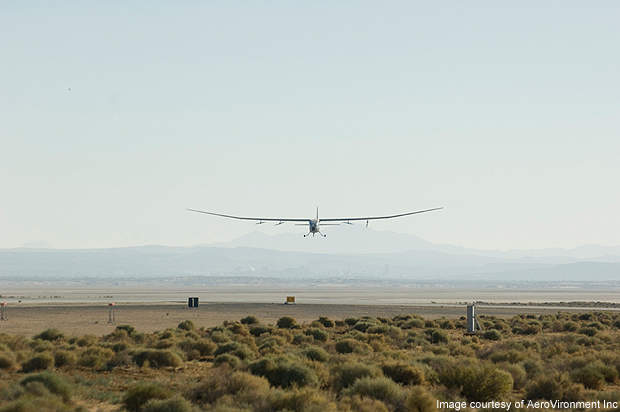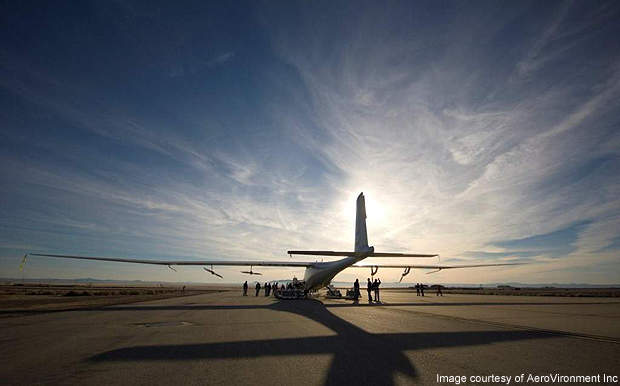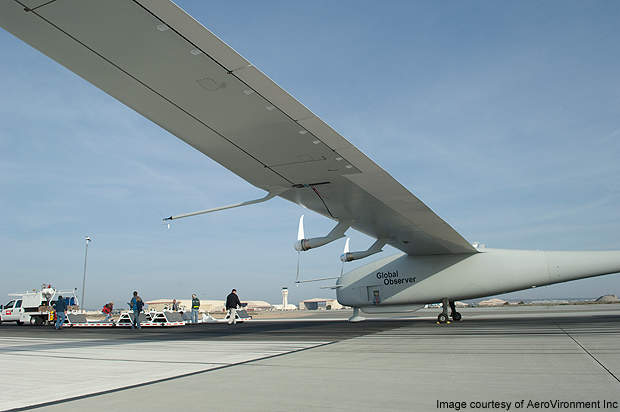Global Observer (GO) is a high-altitude long-endurance unmanned aerial vehicle designed and built by AeroVironment principally for the US Defence and homeland security forces. The UAV will perform intelligence, surveillance and reconnaissance operations without latitude restrictions. The GO is the first UAV to be fitted with a liquid hydrogen fuelled propulsion system. It can be transported by a C-130 aircraft.
The data captured by the aircraft will be transmitted to the ground control station (GCS) through a satellite communication data link. The aircraft completed its maiden flight on 5 August 2010 at Edwards Air Force Base, California, US. Flying at a maximum altitude of 65,000ft (19,812m), the GO can provide its operators with real time intelligence data by executing surveillance and reconnaissance operations over a large area.
Global Observer UAV design
Global Observer has been designed to execute maritime patrol, hurricane or storm tracking, detection and location of electromagnetic interference, and agriculture optimisation operations. The UAV will also perform aerial imaging and mapping, environmental monitoring, disaster relief, wildfire sensing, GPS augmentation and weather monitoring missions. It has been designed to execute significantly longer operations than the Global Hawk UAV.
The GO can render communication relay when cell towers, microwave relays and satellite downlinks are damaged. The UAV will manoeuvre automatically even under adverse weather conditions.
JCTD programme
The joint capability technology demonstration (JCTD) programme was set up by the Department of Defence, Department of Homeland Security and AeroVironment in September 2007. The sponsors for the programme include US Special Operations Command (SOCOM), the US Army, the US Air Force, Department of Homeland Security, the US Defence Threat Reductions Agency (DTRA), the US Strategic Command (SC) and the US Coast Guard.
The joint operational utility assessment (JOUA) is expected to be completed in 2011.
Development
The GO was developed as part of the JCTD programme. Three types namely GO-1, GO-2 and GO-3, the ground control station and modular payloads were developed. About $120m have been spent on the development of the system.
GO-1 is an eight tractor propeller and hydrogen fuel cell power system built for both civil and military applications. It can accommodate 400lbs (181kg) of payload. AeroVironment was awarded a $57m contract by the US Defence Forces in September 2007 to design and build GO-1 as part of the JCTD programme.
GO-1 was sent to Edwards Air Force Base (EAFB) at California in December 2009. The ground quivering and structural modes interaction tests of GO-1 were completed in February 2010 at EAFB. The US Department of Defense, Nasa and AeroVironment team jointly conducted GO-1 aircraft’s flight test in April 2010 to examine its hardware and software.
The initial flight testing of the aircraft was conducted by AeroVironment in October 2010 using batteries to power the hybrid-electric aircraft.
In January 2011, the GO-1 completed its first flight using hydrogen-fuelled propulsion system. The aircraft took off from Edwards Air Force Base (EAFB), California, and flew at an altitude of 5,000ft. It remained in air for four hours over the USAF flight test centre at EAFB.
The GO-1 met with an accident in April 2011 during its ninth flight test. No damage was reported to the civil property. It took off from the EAFB and crashed after 18 hours of flying.
GO-2 is built by AeroVironment for military utility assessment and engineering trade studies thereby making the total contract value $108m.
It can accommodate 1,000lb (453kg) of payload capacity.
The final assembly of the GO-2 was in progress as of May 2010. The UAV’s wing load examination was completed in August 2010. As of April 2011, the production of GO-2 is nearing completion.
GO-3 was ordered in June 2009 and can also accommodate 1,000lb (453kg) of payload.
Navigation
Global Observer can be operated either manually from the GCS or through autonomous mode. The automatic launch and recovery (ALR) system fitted in the GO will allow the aircraft to land safely in case of communication failure between the UAV and the GCS.
The UAV will be equipped with electro optic and infrared sensors.
Ground control station
The GCS is a small, lightweight system which will display real-time videos or images captured by Global Observer. The data provided by the UAV can be processed, retrieved and stored at the GCS. It can also playback videos for target identification and allows for retransmission of videos and information to the operations network.
The GCS can be operated as a remote video terminal (RVT) when implanted at remote location. It will also enable the command centres to view and analyse the data. Assembling and disassembling of the GCS can be done in just two minutes.
Performance
The Global Observer can fly at a maximum speed of 42.5km/h. Its maximum altitude will be 19,812m. The maximum endurance of the aircraft will be 168 hours. The aircraft will weigh around 159kg and its maximum take-off weight will be 1,805kg.





